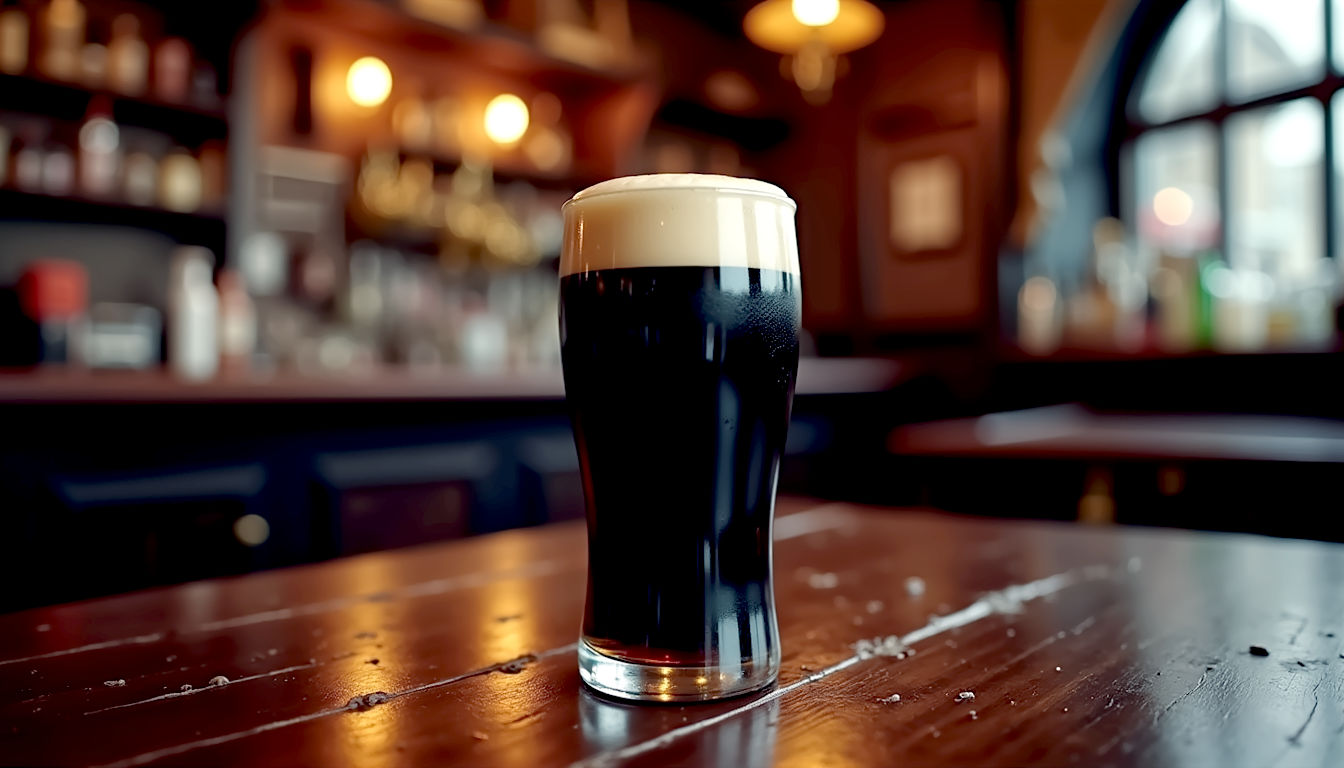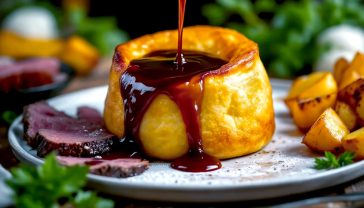The Stout Heart of Ireland: Exploring the Depth of Dark Beers
Our definitive guide to Irish dark beer. Learn about the history of stout, how it’s made, the different styles, and its deep cultural significance.

This post may contain affiliate links. If you make a purchase through these links, we may earn a commission at no additional cost to you.
Pouring a pint of stout is a bit like watching magic happen. You see this dark, almost black liquid swirling in the glass, and then a creamy, thick head settles on top like a perfect, velvety blanket. For many of us here in Britain, a pint of the black stuff, usually Guinness, is a familiar sight in the pub. It’s a taste of Ireland we’ve happily adopted. But there’s a whole world behind that pint glass that goes far beyond just one famous brand.
This is the story of Irish dark beer, a tale that’s wrapped up in history, science, and a deep-rooted culture that has spread across the globe. It’s about more than just a drink; it’s about community, tradition, and the simple pleasure of a well-poured pint. We’re going to journey back in time to 18th-century London, where the story really begins, before crossing the Irish Sea to see how Ireland made this dark beer its own.
We’ll explore how a simple brew became a national symbol, understand what actually goes into making it, and discover that there’s a whole family of stouts out there waiting to be tried—from sweet milk stouts to rich, chocolatey oatmeal stouts. We’ll even look at how to pair them with food (yes, it goes with more than just oysters) and what the future holds for Ireland’s most famous export. So, grab a comfortable seat. This is the complete guide to the stout heart of Ireland.
What Exactly Is Stout? The Basics of a Dark Beer Icon
Before we dive into the deep end, let’s get our heads around what stout actually is. At its simplest, stout is a dark, top-fermented beer made using roasted malt or roasted barley. That “roasted” part is the secret sauce. It’s what gives stout its dark colour and its classic flavours of coffee, dark chocolate, and a hint of caramel.
Think of it like toasting bread. A piece of plain white bread tastes one way, but toast it until it’s dark brown, and you get a completely different, richer flavour. Brewers do the same thing with the grains they use for beer. For stouts, they roast the barley until it’s very dark, and that roasty, toasty character comes through in the final pint.
Stout belongs to the ‘ale’ family of beers. This just means it’s brewed using a type of yeast that works at warmer temperatures and rises to the top of the brewing vessel during fermentation. This is different from lagers, which are brewed with yeast that works at colder temperatures at the bottom. Ales tend to have more complex, fruity flavours, which you can often taste in a good stout.
The Key Ingredients: What Makes a Stout a Stout?
All beer is made from four basic ingredients: water, malt, hops, and yeast. But for stout, it’s the specific type of malt and how it’s treated that makes all the difference.
- Water: The water used for brewing can have a big impact on the final taste. Dublin, the home of Guinness, is famous for its hard water, which is rich in minerals. This type of water is brilliant for brewing dark beers, as it helps to balance out the sharpness from the dark roasted grains, making the beer smoother.
- Malt (and Roasted Barley): This is the soul of the stout. Malt is just barley that has been allowed to sprout and then dried. But for stout, brewers add unmalted, roasted barley into the mix. This is the game-changer. It gives the beer its deep, dark colour and a sharp, coffee-like bitterness that is the hallmark of an Irish stout.
- Hops: Hops are the flowers of a climbing plant that add bitterness, flavour, and aroma to beer. They also act as a natural preservative. In stouts, the hops are there to provide balance. They cut through the sweetness of the malt, stopping the beer from being too cloying. You don’t usually taste strong, floral hop flavours in a classic Irish stout; their job is more subtle here.
- Yeast: This is the tiny living organism that does all the hard work. Yeast eats the sugars from the malt and turns them into alcohol and carbon dioxide (the bubbles). The specific strain of yeast a brewery uses is often a closely guarded secret, as it adds its own unique character and flavours to the beer. The Guinness yeast, for example, has been passed down for generations.
So, when you put it all together, a stout is a dark ale that gets its signature colour and coffee-like taste from roasted barley. It’s balanced by a touch of hop bitterness and fermented with a yeast that adds its own subtle flavours. Simple, yet brilliant.
A Tale of Two Cities: The Surprising History of Stout
You might think the story of stout begins in the cobbled streets of Dublin, but it actually starts a little closer to home, in the bustling, smoky heart of 18th-century London. The tale of how stout became Ireland’s national drink is a fascinating journey of innovation, rivalry, and a bit of clever marketing.
From Porter to Stout: A London Brew Takes Over
Back in the 1700s, London was a thirsty city. The workers hauling goods at the docks and markets, known as ‘porters’, needed a cheap, filling, and nutritious drink to get them through the day. Brewers started making a dark beer called Porter, which was a blend of different beers that was aged and ready to drink straight from the barrel. It was a hit. It was dark, flavourful, and didn’t cost much.
As brewers got better at making it, they started creating different versions. A stronger, richer version of porter came to be known as ‘Stout Porter’. ‘Stout’ was just a common word for ‘strong’ back then, so you could have a stout ale or a stout anything, really. Over time, the name was simply shortened to ‘Stout’. It was the premium, stronger, and more full-bodied version of the everyday porter.
This new style of beer quickly became popular across Britain and, crucially, it made its way across the Irish Sea.
Arthur Guinness and the Birth of an Irish Legend
In Ireland, a man named Arthur Guinness was paying close attention. He had started his brewery at St. James’s Gate in Dublin in 1759, famously signing a 9,000-year lease for the site. At first, he brewed traditional ales, just like everyone else. But he saw the huge popularity of London’s new dark porter and decided he could do it better.
By the 1770s, Guinness had stopped brewing other types of beer altogether to focus solely on porter. He tweaked the recipe, using the unique Dublin water and perfecting his brewing process. His version was so good that he even started exporting it back to England, competing with the London brewers on their home turf.
The real masterstroke came with his version of the stronger brew, ‘Stout Porter’. Guinness Extra Stout Porter became the flagship brew. Just like in London, the ‘Porter’ part of the name was eventually dropped, and by the 19th century, Guinness was synonymous with stout.
Why Did Stout Become So Irish?
So, if stout started in London, how did it become so deeply connected with Ireland? A few things happened.
- The Guinness Factor: Guinness became an incredibly successful and innovative company. They were masters of branding and export. By the late 1800s, Guinness was the largest brewery in the world, sending its stout to the far corners of the British Empire and beyond. For many people, Guinness was stout.
- The Decline of London Porter: As tastes changed in England, lighter ales and pale ales started to become more popular. The big London porter breweries began to fade away, but in Ireland, the love for dark beer remained strong.
- A Symbol of Irish Identity: As Guinness grew, it became a huge source of national pride. It was an Irish success story, a world-class product made right there in Dublin. The brewery was also known for being a good employer, providing its workers with housing, healthcare, and pensions long before this was common. This created a deep sense of loyalty and connection.
Over time, the beer and the nation became inseparable. While the English moved on to other styles, Ireland held stout close to its heart, refining it and making it truly its own. What started as a Londoner’s daily pint had been transformed into a global symbol of Irish culture.
The Art of the Brew: How Is Irish Stout Made?
Making stout is a craft that brewers have perfected over centuries. While the basics are the same as any other beer, the specific steps and ingredients are what create that distinctive dark body and creamy head. Let’s walk through the process, from raw grain to finished pint.
Step 1: Milling and Mashing – Making the Sugary Porridge
The first step is to crack open the grains. The mixture of malted barley and roasted barley is put through a mill, which crushes them to expose the starchy goodness inside. This crushed grain is called ‘grist’.
The grist is then moved to a big vessel called a mash tun. Here, it’s mixed with hot water, creating something that looks a lot like a giant, dark porridge. This process is called mashing. The hot water activates natural enzymes in the malt, which get to work converting the starches in the grain into fermentable sugars. This sugary, malty liquid is called wort (pronounced ‘wert’). After about an hour, the wort is drained from the mash tun, leaving the spent grains behind.
Step 2: The Boil – Adding the Hops
The sweet wort is then transferred to a huge kettle, often called a copper, where it’s boiled for around 90 minutes. This is a crucial stage for a few reasons:
- Sterilisation: The boil kills any unwanted bacteria or wild yeast, ensuring the beer has a clean taste.
- Adding Hops: This is when the hops are thrown in. Hops added at the start of the boil provide the bitterness needed to balance the stout’s malty sweetness. Hops added towards the end would add more aroma, but for a classic Irish stout, the focus is on bitterness rather than floral scents.
- Concentration: The boil evaporates some of the water, concentrating the sugars and flavours in the wort.
Step 3: Fermentation – Where the Magic Happens
After the boil, the hot wort is quickly cooled down and moved to a fermentation vessel. Now it’s time for the most important ingredient: yeast.
The brewery’s special strain of yeast is added to the cooled wort. The yeast immediately starts feasting on the sugars, producing two very important things: alcohol and carbon dioxide (CO2). This process, called fermentation, is what officially turns the sugary wort into beer.
For a stout, which is an ale, this takes place at a relatively warm temperature (around 18-22°C) and can last for several days.
Step 4: Maturation – Letting the Flavours Mellow
Once the fermentation is done, the young, or ‘green’, beer needs some time to mature. It’s moved to conditioning tanks where it’s left to age for a period of time. This allows the flavours to soften and meld together, smoothing out any harsh notes. Any leftover yeast and other solids gradually settle, leaving the beer clearer.
Step 5: The Finishing Touches – Getting That Creamy Head
This is where the famous Irish stout magic comes in. Traditionally, beers are carbonated with CO2. But for that thick, creamy head we associate with stouts like Guinness, something different is needed: nitrogen.
The beer is packaged in kegs with a mixture of nitrogen and carbon dioxide (often called ‘mixed gas’). Nitrogen bubbles are much smaller than CO2 bubbles and are less soluble in liquid. When the stout is poured, these tiny bubbles create a cascade effect (the famous ‘surge’) and form a very tight, stable, and creamy head that lasts all the way to the bottom of the glass.
For canned stouts, brewers use a clever little device called a widget. It’s a small, plastic ball filled with nitrogenated beer. When you open the can, the pressure drops, and the widget releases a jet of tiny nitrogen bubbles, creating that same creamy head you’d get from a pint in the pub. It was a groundbreaking invention that brought the draught experience home.
From the careful roasting of the barley to the final nitrogenation, every step is designed to build layers of flavour and create that unique texture that makes Irish stout so beloved.
A Family of Darkness: Exploring Different Stout Styles
While the classic Irish dry stout, like Guinness, is the undisputed king, it’s just one member of a large and diverse family. Brewers in Ireland and right here in the UK have experimented with the stout recipe over the years, creating a fantastic range of styles. Let’s meet some of the relatives.
Irish Stout (or Dry Stout)
This is the original and most famous style. It’s defined by its roasty, coffee-like flavour that comes from the use of roasted barley. It’s called ‘dry’ because it’s not sweet; the bitterness from the hops and the roasted grain balances everything out. They are typically light-bodied and have a lower alcohol content (usually 4-5% ABV), making them very easy to drink.
- Classic Examples: Guinness Draught, Murphy’s Irish Stout, Beamish Irish Stout.
- Tastes like: Dark roast coffee, a hint of dark chocolate, and a crisp, dry finish.
Milk Stout (or Sweet Stout)
This style first became popular in England in the early 1900s. It was marketed as a nutritious, strengthening drink, even given to nursing mothers! The secret ingredient is lactose, the sugar found in milk.
Yeast can’t ferment lactose, so the sugar stays in the beer after brewing. This gives the milk stout a wonderful, creamy texture and a gentle, lingering sweetness that balances the roasty bitterness.
- Classic Examples: Mackeson Stout, Bristol Beer Factory Milk Stout.
- Tastes like: A milky coffee or a mocha, with a full, creamy body and a sweet finish.
Oatmeal Stout
Another British invention that has become a craft beer favourite. In this style, a small amount of oats is added to the mash along with the barley. Oats don’t add a huge amount of flavour, but they give the beer an incredibly smooth, silky, almost oily texture. It makes for a very rich and luxurious pint.
- Classic Examples: Samuel Smith’s Oatmeal Stout, Founders Breakfast Stout (an American craft example).
- Tastes like: Smooth dark chocolate, coffee, and nuts, with a full-bodied and silky mouthfeel.
Oyster Stout
This one sounds a bit strange, but it has a long history. Oysters and stout were a classic food pairing in Victorian London pubs – a cheap and nutritious meal for the working class. Some brewers took it a step further and decided to put the oysters in the beer.
Some brewers just use the oyster shells, which are rich in calcium carbonate and can help clarify the beer. Others are more daring and add the whole oyster to the boil. Don’t worry, it doesn’t make the beer taste fishy! Instead, it adds a subtle salty, briny character and a touch of smoothness.
- Classic Examples: The Porterhouse Brewing Co. Oyster Stout, Marston’s Oyster Stout.
- Tastes like: A classic dry stout with an added hint of sea salt and a slightly savoury, mineral-like complexity.
Foreign Extra Stout (FES)
This is the globetrotting big brother of the Irish dry stout. It was originally brewed to be a stronger, more heavily hopped version that could survive the long sea voyages to Africa, the Caribbean, and Asia. It’s got more of everything: more alcohol (often 6-8% ABV), more roastiness, and more bitterness. The higher alcohol content also gives it a slightly sweet, fruity character.
- Classic Examples: Guinness Foreign Extra Stout (the original), The Kernel Export Stout London.
- Tastes like: Intense dark chocolate, strong coffee, dark fruits like plums and raisins, with a warming alcoholic kick.
Imperial Stout
If Foreign Extra Stout is the big brother, then Imperial Stout is the heavyweight champion of the world. This style was first brewed in London in the 18th century for export to the court of Catherine the Great of Russia. To survive the cold journey, it had to be incredibly strong, often with an alcohol content of 9% or more.
Today, craft brewers have embraced Imperial Stout, pushing the boundaries with intense flavours of treacle, burnt sugar, dark fruit, and chocolate, all wrapped in a thick, velvety body. It’s a beer to be sipped and savoured, not drunk by the pint.
- Classic Examples: Samuel Smith’s Imperial Stout, North Brewing Co. Transmission (a modern UK example).
- Tastes like: A boozy chocolate liqueur, burnt caramel, dark fruit cake, and a rich, warming finish.
More Than a Pint: Stout in Irish Culture
In Ireland, stout is more than just a popular drink; it’s woven into the very fabric of society. It’s a cultural shorthand, a symbol of home, and the centrepiece of that unique institution: the Irish pub. Understanding its place in culture is key to understanding the beer itself.
The Pub: The Heart of the Community
For centuries, the pub has been the living room of Irish communities. It’s where news is shared, deals are made, music is played, and stories are told. And at the centre of it all is the pint of stout.
Ordering a pint isn’t just a transaction; it’s a ritual. There’s the ‘split the G’ challenge on the Guinness harp, the friendly debate over which pub serves the best pint, and the collective sigh of satisfaction as a perfectly settled pint is placed on the bar. It’s a social lubricant that brings people together, from old farmers in a quiet rural pub to young tech workers in a bustling Dublin bar.
“Good for You”: The Myth and The Reality
For generations, Guinness was famously marketed with the slogan “Guinness is Good for You.” This wasn’t just clever advertising; it was widely believed. Doctors would prescribe it to pregnant women, nursing mothers, and even patients recovering from surgery, thanks to its high iron content. Post-war blood donors in the UK were often given a free bottle to help them recover.
While modern science has shown that no alcoholic drink is truly a ‘health food’, the belief has stuck around. A pint of Guinness actually has fewer calories than the same amount of skimmed milk or orange juice, and it does contain antioxidants and iron. But the idea of stout as a wholesome, restorative drink is a powerful part of its cultural identity.
A Taste of Home, Wherever You Are
Irish people have emigrated all over the world, and they’ve taken their love of stout with them. The sight of a Guinness harp or a Murphy’s tap in a bar in Sydney, New York, or Dubai is an instant connection to home.
The global network of Irish pubs, from authentic, family-run establishments to modern chain bars, all have one thing in common: the stout must be poured correctly. It’s a benchmark of authenticity. These pubs act as cultural embassies, and the dark pint on the bar is the flag. On St. Patrick’s Day, millions of people around the world, Irish or not, will raise a pint of stout in celebration. It has become a universal symbol of Irishness.
A Perfect Match: Pairing Food with Stout
The rich, complex flavours of stout make it a surprisingly brilliant partner for food. Its roasty bitterness can cut through rich dishes, while its chocolate and coffee notes can complement a wide range of flavours. Forget the old rules about wine; beer is just as versatile at the dinner table. Here are some classic and unexpected pairings to try.
Classic Comforts
- Oysters: This is the most legendary pairing of them all. The salty, briny tang of a fresh oyster is the perfect contrast to the creamy, roasted bitterness of a dry stout. The beer cleanses your palate, getting you ready for the next one. An absolute classic.
- Beef and Guinness Stew: It’s a classic for a reason. The stout works in two ways here. In the stew itself, its rich, malty flavours add incredible depth to the gravy. And a pint served alongside cuts through the richness of the meat, making every bite taste as good as the first.
- Smoked Fish: The roasty notes in a stout are a fantastic match for smoky flavours. Try a pint with smoked salmon, smoked mackerel, or a classic kipper. The beer’s light acidity and carbonation lift the oily fish.
Cheese and Stout
Stout and cheese is a match made in heaven. The beer’s robust flavours can stand up to even the strongest cheeses.
- Strong Cheddar: A sharp, crumbly British Cheddar is fantastic with a dry stout. The beer’s bitterness cuts through the fat in the cheese, and its roasty notes complement the cheese’s nutty flavour.
- Blue Cheese: This is a bold pairing that really works. The creamy sweetness of a milk stout or the rich fruitiness of a Foreign Extra Stout can beautifully balance the salty, tangy funk of a Stilton or Cashel Blue.
Sweet Surprises
Don’t forget dessert! The chocolate and coffee flavours in stout make it a natural partner for sweet dishes.
- Chocolate Cake: This is a no-brainer. A rich, dark chocolate cake or brownie served with a milk stout or an oatmeal stout is pure indulgence. The beer acts like a creamy sauce, amplifying the chocolate flavour.
- Ice Cream: A stout float is a grown-up treat you have to try. Pour a rich Imperial Stout over a scoop of good quality vanilla or coffee ice cream. The result is a creamy, boozy, delicious mess.
The Future of Irish Dark Beer: Tradition Meets Innovation
The world of beer is always changing. While the classic Irish stouts remain as popular as ever, a new generation of craft brewers is breathing fresh life into this historic style. The future of Irish dark beer looks to be an exciting mix of respecting tradition and embracing new ideas.
The Craft Beer Revolution
For decades, the Irish beer market was dominated by a few huge brands. But in the last 15 years, Ireland, just like the UK, has seen an explosion of small, independent craft breweries. These brewers are digging into Ireland’s brewing heritage and putting their own creative spins on classic styles.
You can now find Irish-brewed milk stouts, oatmeal stouts, and powerful Imperial Stouts packed with new and exciting flavours like vanilla, chilli, or barrel-ageing in old whiskey casks. Breweries like The White Hag, Galway Bay Brewery, and Kinnegar Brewing are creating world-class stouts that are gaining attention far beyond Ireland.
A Focus on Quality and Provenance
Today’s beer drinkers are more knowledgeable and curious than ever. They want to know where their beer comes from and what’s in it. This has led to a renewed focus on quality ingredients. Some breweries are working with local farmers to source Irish-grown barley and hops, bringing a true taste of the local land, or ‘terroir’, to their beers.
Stout in a Modern World
While the image of an old man sipping a pint in a quiet pub is timeless, stout is also finding a new audience. Breweries are packaging their stouts in modern, eye-catching cans and creating beers that appeal to a younger generation of drinkers who are looking for flavour and authenticity.
The classic pint of Guinness isn’t going anywhere. It remains a masterpiece of brewing and a global icon. But alongside it, a vibrant and creative scene is ensuring that the story of Irish dark beer has many more exciting chapters yet to be written. From its humble beginnings in 18th-century London to its status as a cultural symbol and its reinvention by modern craft brewers, stout has proven to be a beer of incredible depth and resilience. It truly is the stout heart of Ireland.
Further Reading
For those wishing to delve deeper into the world of Irish beer and brewing, these resources are highly recommended:
- Beoir (www.beoir.org): An independent group supporting and campaigning for Irish craft beer, with great resources and brewery listings.
- Get ‘Er Brewed: Brewing blog discussing all aspects of craft brewing.
- The Beer Nut: Beer and drinks blogger with lots of great content for the real ale enthusiast.






